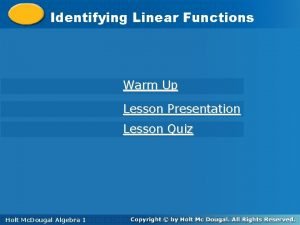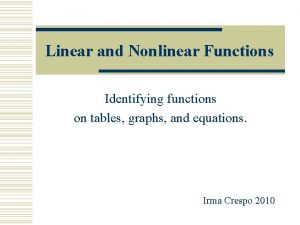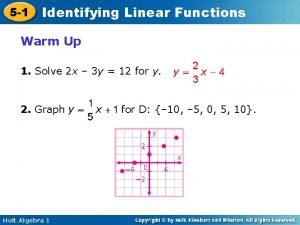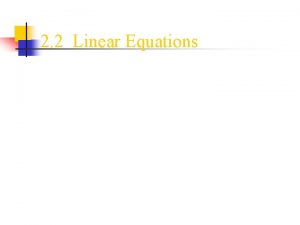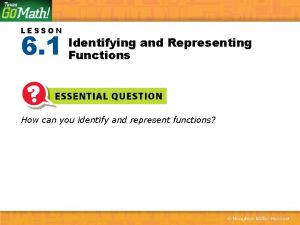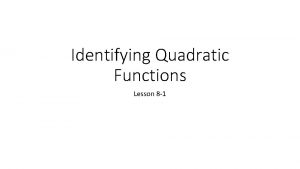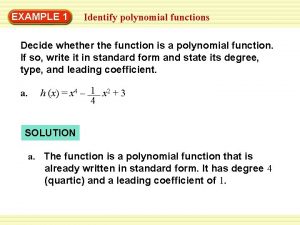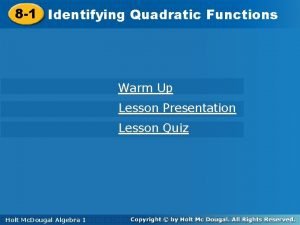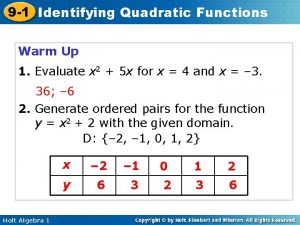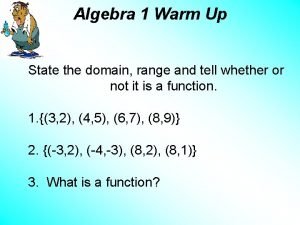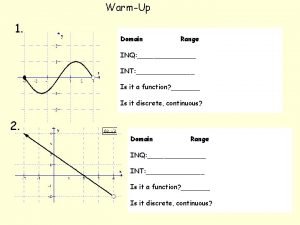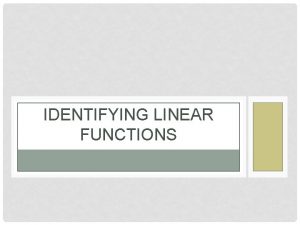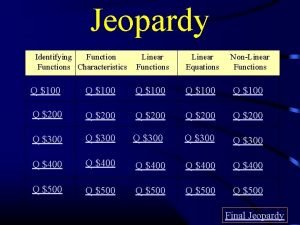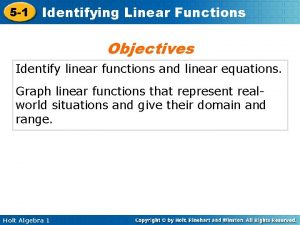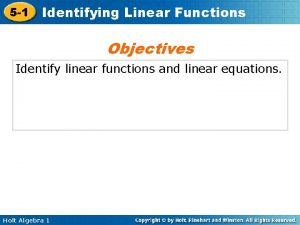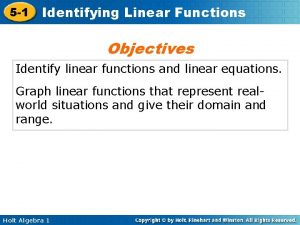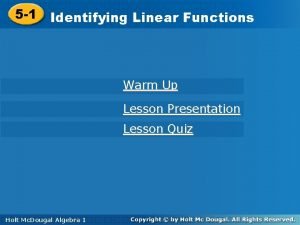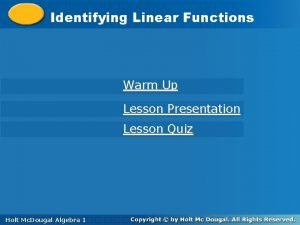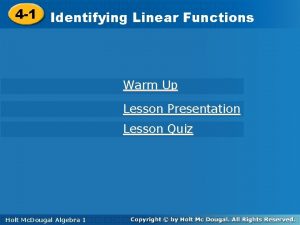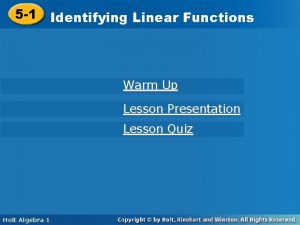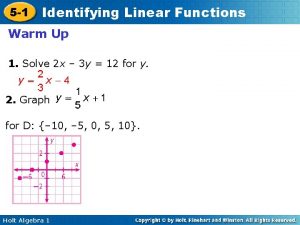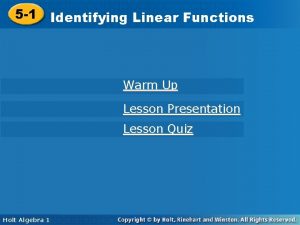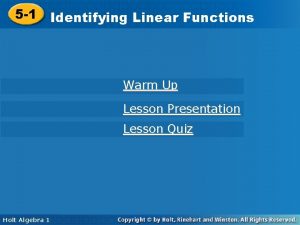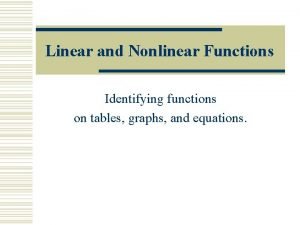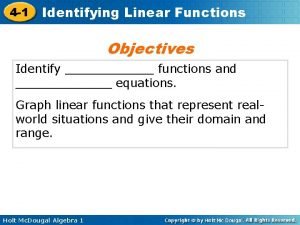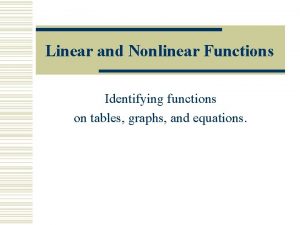5 1 Identifying Linear Functions Warm Up 1





















- Slides: 21

5 -1 Identifying Linear Functions Warm Up 1. Solve 2 x – 3 y = 12 for y. 2. Graph Holt Algebra 1 for D: {– 10, – 5, 0, 5, 10}.

5 -1 Identifying Linear Functions Objectives Identify linear functions and linear equations. Graph linear functions that represent realworld situations and give their domain and range. Holt Algebra 1

5 -1 Identifying Linear Functions Vocabulary linear function linear equation Holt Algebra 1

5 -1 Identifying Linear Functions The graph represents a function because each domain value (x-value) is paired with exactly one range value (y-value). Notice that the graph is a straight line. A function whose graph forms a straight line is called a linear function. Holt Algebra 1

5 -1 Identifying Linear Functions Directions: Identify whether the graph represents a function. Explain. If the graph does represent a function, is the function linear? Holt Algebra 1

5 -1 Identifying Linear Functions Example 1 Each domain value is paired with exactly one range value. The graph forms a linear function Holt Algebra 1

5 -1 Identifying Linear Functions Example 2 Each domain value is paired with exactly one range value. The graph is not a linear function Holt Algebra 1

5 -1 Identifying Linear Functions Example 3 Identify whether the graph represents a function. Explain. If the graph does represent a function, is the function linear? The only domain value, – 2, is paired with many different range values. not a function Holt Algebra 1

5 -1 Identifying Linear Functions You can sometimes identify a linear function by looking a table or a list of ordered pairs. In a linear function, a constant change in x corresponds to a constant change in y. Directions: Tell whether the set of ordered pairs satisfies a linear function. Explain. Holt Algebra 1

5 -1 Identifying Linear Functions Example 5 {(0, – 3), (4, 0), (8, 3), (12, 6), (16, 9)} x +4 +4 Holt Algebra 1 y 0 – 3 4 0 8 3 12 6 16 9 +3 +3 Write the ordered pairs in a table. Look for a pattern. A constant change of +4 in x corresponds to a constant change of +3 in y. These points satisfy a linear function.

5 -1 Identifying Linear Functions Example 6 {(– 4, 13), (– 2, 1), (0, – 3), (2, 1), (4, 13)} +2 +2 Holt Algebra 1 x y – 4 13 – 2 1 0 – 3 2 1 4 13 – 12 – 4 +4 +12 Write the ordered pairs in a table. Look for a pattern. A constant change of 2 in x corresponds to different changes in y. These points do not satisfy a linear function.

5 -1 Identifying Linear Functions Another way to determine whether a function is linear is to look at its equation. A function is linear if it is described by a linear equation. A linear equation is any equation that can be written in the standard form shown below. Holt Algebra 1

5 -1 Identifying Linear Functions Notice that when a linear equation is written in standard form • x and y both have exponents of 1. • x and y are not multiplied together. • x and y do not appear in denominators, exponents, or radical signs. Holt Algebra 1

5 -1 Identifying Linear Functions Holt Algebra 1

5 -1 Identifying Linear Functions For any two points, there is exactly one line that contains them both. This means you need only two ordered pairs to graph a line. Directions: Write the equation in Standard Form. Tell whether the function is linear. Holt Algebra 1

5 -1 Identifying Linear Functions Example 7 x = 2 y + 4 – 2 y x – 2 y = 4 Write the equation in standard form. Try to get both variables on the same side. Subtract 2 y from both sides. The equation is in standard form (A = 1, B = – 2, C = 4). The equation can be written in standard form, so the function is linear. Holt Algebra 1

5 -1 Identifying Linear Functions Example 8 xy = 4 This is not linear, because x and y are multiplied. It is not in standard form. Holt Algebra 1

5 -1 Identifying Linear Functions Example 10 y = 12 The equation is in standard form (A = 0, B = 1, C = 12). The equation can be written in standard form, so the function is linear. Holt Algebra 1

5 -1 Identifying Linear Functions Example 11 y = 2 x This is not linear, because x is an exponent. Holt Algebra 1

5 -1 Identifying Linear Functions Lesson Summary: Part I Tell whether each set of ordered pairs satisfies a linear function. Explain. 1. {(– 3, 10), (– 1, 9), (1, 7), (3, 4), (5, 0)} No; a constant change of +2 in x corresponds to different changes in y. 2. {(3, 4), (5, 7), (7, 10), (9, 13), (11, 16)} Yes; a constant change of +2 in x corresponds to a constant change of +3 in y. Holt Algebra 1

5 -1 Identifying Linear Functions Lesson Summary: Part II Tell whether each function is linear. If so, graph the function. 3. y = 3 – 2 x no 4. 3 y = 12 yes Holt Algebra 1
 How can you identify a linear function
How can you identify a linear function Linear and nonlinear tables worksheet
Linear and nonlinear tables worksheet 5-1 identifying linear functions answer key
5-1 identifying linear functions answer key Adjective
Adjective Non identifying adjective clauses examples
Non identifying adjective clauses examples Information essential
Information essential Standard form linear equation
Standard form linear equation Identifying and representing functions answer key
Identifying and representing functions answer key Lesson 8 extra practice quadratic functions
Lesson 8 extra practice quadratic functions Polynomial examples
Polynomial examples Identifying even and odd functions
Identifying even and odd functions Lesson 8-1 identifying quadratic functions
Lesson 8-1 identifying quadratic functions 9-1 identifying quadratic functions
9-1 identifying quadratic functions What is domain and range in algebra 1
What is domain and range in algebra 1 What is the domain and range of the function
What is the domain and range of the function Simple multiple linear regression
Simple multiple linear regression Contoh persamaan non linear
Contoh persamaan non linear Linear and non linear text
Linear and non linear text Example of non linear plot
Example of non linear plot Contoh soal metode tabel
Contoh soal metode tabel Linear and non linear pipeline
Linear and non linear pipeline Examples of linear multimedia
Examples of linear multimedia
